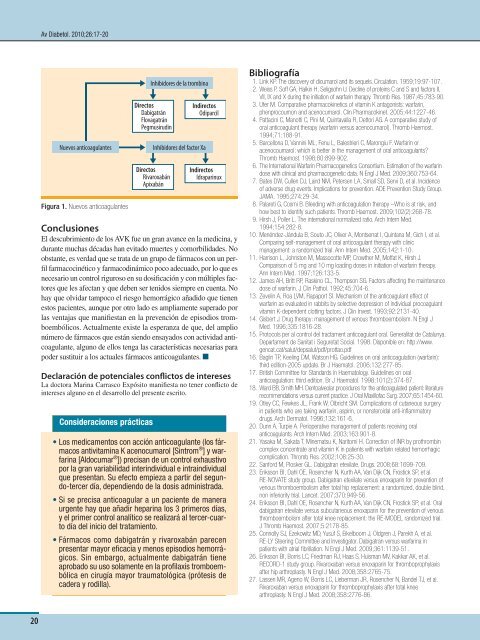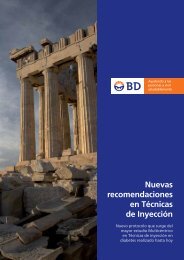AVD%2026(1)
AVD%2026(1)
AVD%2026(1)
You also want an ePaper? Increase the reach of your titles
YUMPU automatically turns print PDFs into web optimized ePapers that Google loves.
20<br />
Av Diabetol. 2010;26:17-20<br />
Nuevos anticoagulantes<br />
Figura 1. Nuevos anticoagulantes<br />
Inhibidores de la trombina<br />
Directos<br />
Dabigatrán<br />
Flovagatrán<br />
Pegmusirudin<br />
Inhibidores del factor Xa<br />
Directos<br />
Rivaroxabán<br />
Apixabán<br />
Indirectos<br />
Odiparcil<br />
Indirectos<br />
Idraparinux<br />
Conclusiones<br />
El descubrimiento de los AVK fue un gran avance en la medicina, y<br />
durante muchas décadas han evitado muertes y comorbilidades. No<br />
obstante, es verdad que se trata de un grupo de fármacos con un per-<br />
l farmacocinético y farmacodinámico poco adecuado, por lo que es<br />
necesario un control riguroso en su dosi cación y con múltiples factores<br />
que les afectan y que deben ser tenidos siempre en cuenta. No<br />
hay que olvidar tampoco el riesgo hemorrágico añadido que tienen<br />
estos pacientes, aunque por otro lado es ampliamente superado por<br />
las ventajas que mani estan en la prevención de episodios tromboem<br />
bólicos. Actualmente existe la esperanza de que, del amplio<br />
número de fármacos que están siendo ensayados con actividad anticoagulante,<br />
alguno de ellos tenga las características necesarias para<br />
poder sustituir a los actuales fármacos anticoagulantes. ■<br />
Declaración de potenciales confl ictos de intereses<br />
La doctora Marina Carrasco Expósito mani esta no tener con icto de<br />
intereses alguno en el desarrollo del presente escrito.<br />
Consideraciones prácticas<br />
• Los medicamentos con acción anticoagulante (los fármacos<br />
antivitamina K acenocumarol [Sintrom ® ] y warfarina<br />
[Aldocumar ® ]) precisan de un control exhaustivo<br />
por la gran variabilidad interindividual e intraindividual<br />
que presentan. Su efecto empieza a partir del segundo-tercer<br />
día, dependiendo de la dosis administrada.<br />
• Si se precisa anticoagular a un paciente de manera<br />
urgente hay que añadir heparina los 3 primeros días,<br />
y el primer control analítico se realizará al tercer-cuarto<br />
día del inicio del tratamiento.<br />
• Fármacos como dabigatrán y rivaroxabán parecen<br />
presentar mayor efi cacia y menos episodios hemorrágicos.<br />
Sin embargo, actualmente dabigatrán tiene<br />
aprobado su uso solamente en la profi laxis tromboembólica<br />
en cirugía mayor traumatológica (prótesis de<br />
cadera y rodilla).<br />
Bibliografía<br />
1. Link KP. The discovery of dicumarol and its sequels. Circulation. 1959;19:97-107.<br />
2. Weiss P, Soff GA, Halkin H, Seligsohn U. Decline of proteins C and S and factors II,<br />
VII, IX and X during the initiation of warfarin therapy. Thromb Res. 1987;45:783-90.<br />
3. Ufer M. Comparative pharmacokinetics of vitamin K antagonists: warfarin,<br />
phenprocoumon and acenocumarol. Clin Pharmacokinet. 2005;44:1227-46.<br />
4. Pattacini C, Manotti C, Pini M, Quintavalla R, Dettori AG. A comparative study of<br />
oral anticoagulant therapy (warfarin versus acenocumarol). Thromb Haemost.<br />
1994;71:188-91.<br />
5. Barcellona D, Vannini ML, Fenu L, Balestrieri C, Marongiu F. Warfarin or<br />
acenocoumarol: which is better in the management of oral anticoagulants?<br />
Thromb Haemost. 1998;80:899-902.<br />
6. The International Warfarin Pharmacogenetics Consortium. Estimation of the warfarin<br />
dose with clinical and pharmacogenetic data. N Engl J Med. 2009;360:753-64.<br />
7. Bates DW, Cullen DJ, Laird NM, Petersen LA, Small SD, Servi D, et al. Incidence<br />
of adverse drug events. Implications for prevention. ADE Prevention Study Group.<br />
JAMA. 1995;274:29-34.<br />
8. Palareti G, Cosmi B. Bleeding with anticoagulation therapy –Who is at risk, and<br />
how best to identify such patients. Thromb Haemost. 2009;102(2):268-78.<br />
9. Hirsh J, Poller L. The international normalized ratio. Arch Intern Med.<br />
1994;154:282-8.<br />
10. Menéndez-Jándula B, Souto JC, Oliver A, Montserrat I, Quintana M, Gich I, et al.<br />
Comparing self-management of oral anticoagulant therapy with clinic<br />
management: a randomized trial. Ann Intern Med. 2005;142:1-10.<br />
11. Harrison L, Johnston M, Massocotte MP, Crowther M, Moffat K, Hirsh J.<br />
Comparison of 5 mg and 10 mg loading doses in initiation of warfarin therapy.<br />
Ann Intern Med. 1997;126:133-5.<br />
12. James AH, Britt RP, Raskino CL, Thompson SG. Factors affecting the maintenance<br />
dose of warfarin. J Clin Pathol. 1992;45:704-6.<br />
13. Zevelin A, Roa LVM, Rapaport SI. Mechanism of the anticoagulant effect of<br />
warfarin as evaluated in rabbits by selective depression of individual procoagulant<br />
vitamin K-dependent clotting factors. J Clin Invest. 1993;92:2131-40.<br />
14. Gisbert J. Drug therapy: management of venous thromboembolism. N Engl J<br />
Med. 1996;335:1816-28.<br />
15. Protocols per al control del tractament anticoagulant oral. Generalitat de Catalunya.<br />
Departament de Sanitat i Seguretat Social. 1998. Disponible en: http://www.<br />
gencat.cat/salut/depsalut/pdf/prottao.pdf<br />
16. Baglin TP, Keeling DM, Watson HG. Guidelines on oral anticoagulation (warfarin):<br />
third edition-2005 update. Br J Haematol. 2006;132:277-85.<br />
17. British Committee for Standards in Haematology. Guidelines on oral<br />
anticoagulation: third edition. Br J Haematol. 1998;101(2):374-87.<br />
18. Ward BB, Smith MH. Dentoalveolar procedures for the anticoagulated patient: literature<br />
recommendations versus current practice. J Oral Maxillofac Surg. 2007;65:1454-60.<br />
19. Otley CC, Fewkes JL, Frank W, Olbricht SM. Complications of cutaneous surgery<br />
in patients who are taking warfarin, aspirin, or nonsteroidal anti-infl ammatory<br />
drugs. Arch Dermatol. 1996;132:161-6.<br />
20. Dunn A, Turpie A. Perioperative management of patients receiving oral<br />
anticoagulants. Arch Intern Med. 2003;163:901-8.<br />
21. Yasaka M, Sakata T, Minematsu K, Naritomi H. Correction of INR by prothrombin<br />
complex concentrate and vitamin K in patients with warfarin related hemorrhagic<br />
complication. Thromb Res. 2002;108:25-30.<br />
22. Sanford M, Plosker GL. Dabigatran etexilate. Drugs. 2008;68:1699-709.<br />
23. Eriksson BI, Dahl OE, Rosencher N, Kurth AA, Van Dijk CN, Frostick SP, et al.<br />
RE-NOVATE study group. Dabigatran etexilate versus enoxaparin for prevention of<br />
venous thromboembolism after total hip replacement: a randomized, double blind,<br />
non inferiority trial. Lancet. 2007;370:949-56.<br />
24. Eriksson BI, Dahl OE, Rosencher N, Kurth AA, Van Dijk CN, Frostick SP, et al. Oral<br />
dabigatran etexilate versus subcutaneous enoxaparin for the prevention of venous<br />
thromboembolism after total knee replacement: the RE-MODEL randomized trial.<br />
J Thromb Haemost. 2007;5:2178-85.<br />
25. Connolly SJ, Ezekowitz MD, Yusuf S, Eikelboom J, Oldgren J, Parekh A, et al.<br />
RE-LY Steering Committee and Investigator. Dabigatran versus warfarina in<br />
patients with atrial fi brillation. N Engl J Med. 2009;361:1139-51.<br />
26. Eriksson BI, Borris LC, Friedman RJ, Haas S, Huisman MV, Kakkar AK, et al.<br />
RECORD-1 study group. Rivaroxaban versus enoxaparin for thromboprophylaxis<br />
after hip arthroplasty. N Engl J Med. 2008;358:2765-75.<br />
27. Lassen MR, Ageno W, Borris LC, Lieberman JR, Rosencher N, Bandel TJ, et al.<br />
Rivaroxaban versus enoxaparin for thromboprophylaxis after total knee<br />
arthroplasty. N Engl J Med. 2008;358:2776-86.



